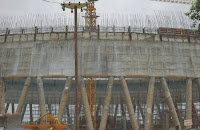INTRODUCTION
Due to global warming the temperature is rising day by day and has become a concern for both
the environment and human life.
The concept of Green Building has evolved to create environment friendly buildings and reduce the overall impact on human health. LEED certification is the recognized standard for measuring building sustainability. Achieving LEED certification is the best way to demonstrate that your building project is truly "green."
Insulation of concrete is an important factor because it provides an ultra-efficient, high mass, high strength, and very durable building shell that keeps occupants of the building/ home healthy and comfortable.
Proper insulation of walls, ceilings and floors significantly reduces the loss of heat to the outdoors. Insulation will pay for itself in fuel cost savings and home comfort. This can save >30 percent of home heating bills and reduce CO emissions. Whenever you save energy, 2
you not only save money but also reduce the demand for such fossil fuels as coal, oil, and natural gas. Less burning of fossil fuels also means lower emissions of carbon dioxide (CO ), the 2 primary contributor to global warming and other pollutants. We offer a range of insulation options to ensure that we have the best solution for your home in your budget.
We,
FAIRMATE have introduced eco-friendly energy saving products for Green Building certification for the development of our environment. Already, we have started formalities for getting approval from concerned International Authority for our energy saving Green Building
products.
We have following products :
WATERGUARD I - An insulating waterproof coating
- Durable and high UV resistance
- Excellent bonding to cement base substrates.
- Excellent resistance to water and provides good insulation property.
- Can be used as a thermal insulation coating on concrete, roof slabs and walls of building.
- Excellent flexibility.
- Available in attractive white color.
- No of coats required to get best performance
FAIRPLASTER E (I) - An insulating wall putty
- Consistent quality compound for inert filler material.
- Excellent waterproofing systems and provides good insulation property.
- Excellent frost resistance.
- Excellent finishing.
- Available in white color so excellent heat resistant.
FAIRCOAT INSULTECH - A thermal insulation anti-carbonation coating
- Good weathering property.
- Improved temperature control and anti-carbonation quality.
- Gives temperature reduction of about 8% to 10%.
- Gap bridging properties.
- Requires less maintenance.
All of these products are designed to reflect 90% of the radiant energy of the sun and resists
the ultraviolet degradation
HOW IT WORKS AGAINST SOLAR ENERGY ?
When solar radiation strikes on uncoated roof, it is converted into Infra Red radiation. This radiated energy passes down through the roof and is absorbed by building components i.e. wall, ceiling, etc. Due to solar energy conservation, electricity consumption increases. An untreated roof or building component reflects less and absorbs more heat hence, temperature inside the building rises drastically.
WATERGUARD I has got a high reflectivity when applied on roof and building exteriors. It acts as a radiant barrier which initially absorbs solar energy and then releases the heat which avoids high temperature formation in a room.
Any built-up energy in a building is absorbed back through the roof, allowing the building to cool rapidly. Traditional roof materials retain heat in a building throughout the night because of their low emitance values. The density of the ceramic particles resists wear and degradation from ultra violet radiation, extending the useful life of the system. The insulating effect of the products remains constant throughout its useful life.
Normally, illumination consumes about 15% electricity in domestic use. FAIRMATE make insulation products cuts down the power consumption and saves electricity tariff (charges) upto 30%. At the same time, it protects the environment by reducing the amount of energy that is generated to heat buildings, thereby decreasing the amount of pollution released into the air. By the application of these products, we can reduce the consumption of the electricity and conserve energy.
CONCLUSION
The insulation coatings when applied to a roof can lower the roof temperatures thereby decreasing the amount of heat transferred into a building's interior. These coatings can save energy and money over the life of a roof or walls by reducing the amount of air conditioning
needed to keep a building comfortable. In addition to this, these products can potentially minimize the effects associated with thermal shock, reduce UV degradation and extend the life of the roofs and walls. Also, they provide the easiest and most effective way to:
- Save money (> 30%) on your energy bills
- Improve the overall comfort level of your home
- Increase the value of your home and
- Do your part to help conserve our nation's limited energy resources
These products also reduce the amount of energy needed to cool buildings which helps to
reduce the production of air pollutants as well.


















